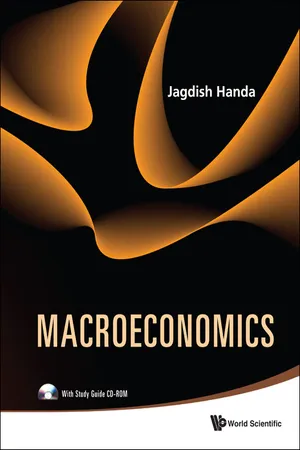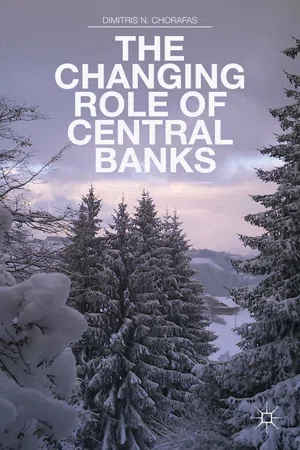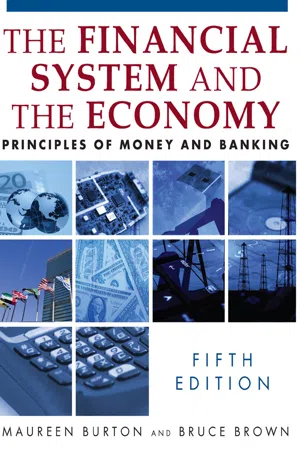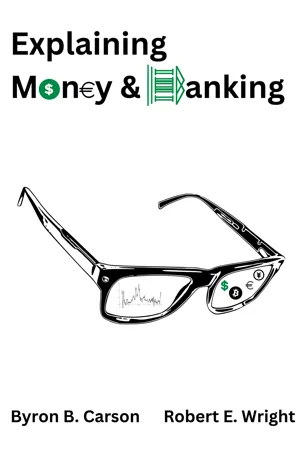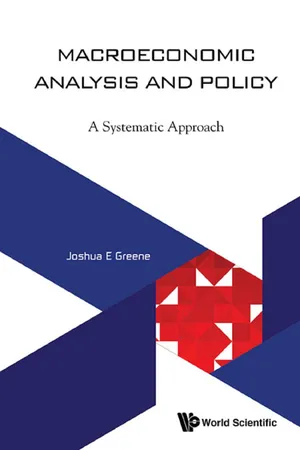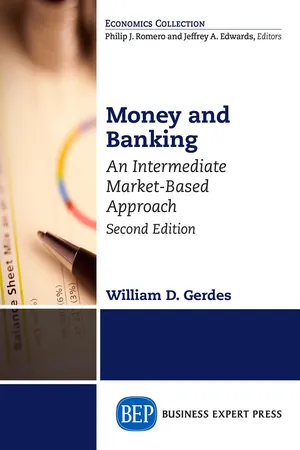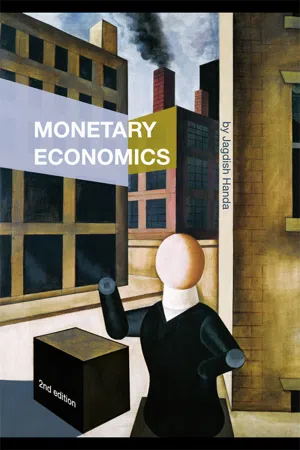Economics
Monetary Base
Monetary base refers to the total amount of a country's currency in circulation, including physical currency and commercial banks' reserves held at the central bank. It is a key indicator of a country's money supply and is used by central banks to influence economic activity through monetary policy. Changes in the monetary base can impact inflation, interest rates, and overall economic stability.
Written by Perlego with AI-assistance
Related key terms
Related key terms
1 of 4
Related key terms
1 of 3
10 Key excerpts on "Monetary Base"
- eBook - ePub
Macroeconomics
(With Study Guide CD-ROM)
- Jagdish Handa(Author)
- 2010(Publication Date)
- WSPC(Publisher)
14 stands for the Monetary Base. It generic definition is:M 0 = currency in the hands of the non-bank public + currency held by the commercial banks + deposits held by the commercial banks at the central bank.The reserves held by the commercial banks are called bank reserves and are designated by the symbol R. Bank reserves for the banking system as a whole are defined as:R = currency held by the commercial banks + deposits held by the commercial banks at the central bank.Therefore, we have:M 0 = C + R.Note the difference between the Monetary Base M 0 and the money supply M 1. M 1 = C + D , where D is demand deposits of the public in commercial banks, while M 0 = C + R .2.8.1 The relationship between the Monetary Base and the money supplyThe central bank controls the Monetary Base through its purchases and sales of bonds to the public. A purchase of bonds means that the central bank pays for them by transferring funds from itself to the public, which increases the Monetary Base. A sale of bonds means that the central bank receives funds from the public, which decreases the Monetary Base. These sales or purchases of bonds in the financial markets are called open market operations. They are a major element in the central bank’s control of the Monetary Base and the money supply.The money supply is related to the Monetary Base by the equation: where:M 1 = narrow money supply, M 0 = Monetary Base, and α1 = Monetary Base multiplier (= ∂M 1/∂M 0) for M1. The coefficient a1 represents the increase in the money supply M1 for a unit change in the Monetary Base M 0. Its value is usually greater than one. In fact, a value of three or four is not unusual for it for the modern economies. This implies that a change in the Monetary Base engineered by the central bank increases the money supply by the multiple α1 , so that it is called the Monetary Base (to the money supply) multiplier.15 The broader the definition of the monetary aggregate, the larger will be the relevant multiplier. For M - eBook - ePub
- D. Chorafas(Author)
- 2013(Publication Date)
- Palgrave Macmillan(Publisher)
2. Monetary Base and Money SupplyThere is considerable consensus on the fact that a well-organized, stable monetary system is one of the most basic prerequisites for a prosperous economy. Experience also shows that the creation of money has to be regulated by a body that is neither under political pressure nor a market player. This essentially means that it is independent from the government (chapter 6 ). As we saw in section 1 this role is given to central banks, which are entrusted with the:• Exercise of a note-issuing monopoly, and• Adjustment of the currency’s circulation to the needs of the private and public sectors, without creating inflationary pressures.As far as central banks are concerned the task of money issuing was somewhat simpler when gold occupied a focal position in the monetary system, and banknotes were merely regarded as substitute money. This is not the case today and the abandoning of the gold standard has made monetary policy more complex and more precarious.The relationship between money and the economy has interested economists for centuries and given rise to widely contradictory economic theories. There exists, as well, a theoretical disagreement. Some economists think that money and the economy are highly correlated, while others believe that their relationship is not that close because between the two come social issues. No matter which theory prevails, we need measurements to gauge how the supply of money in the economy affects:• Liquidity in the market• Employment patterns,• Prices, and• Inflation.Abrupt changes in price level are liable to send out distress signals and possibly lead to expensive mistakes in planning and investment. According to Robert Fluri and Erich Spoerndli of the Swiss National Bank, “For most of the measures studied, money does, as expected, help to predict prices and output in the short run as well as in the long run. The predictive information content of money regarding shorter-run price movements is in general not impressively high when other available information is incorporated.”2 - eBook - ePub
The Financial System and the Economy
Principles of Money and Banking
- Maureen Burton, Bruce Brown(Authors)
- 2014(Publication Date)
- Routledge(Publisher)
http://research.stlouisfed.org/fred2/categories/45.html.Fedpoint 4 describes the repurchase and matched-sale transaction, initiated at the trading desk of the New York Fed, at http://www.newyorkfed.org/aboutthefed/fedpoint/fed04.html.Appendix 19A Other Factors That Affect the Monetary Base$o far you have seen that the Fed, through open market operations, can change reserves and the Monetary Base. Although initially altering reserves, open market operations ultimately tend to change both reserves and the amount of currency held by the public. Although the Fed undoubtedly has enormous influence over reserve assets, other factors also affect them. This appendix identifies the various other factors that can affect reserves (and the Monetary Base) and shows how, despite these other factors, the Fed still exerts considerable influence over reserves, the Monetary Base, interest rates, and lending. The Fed monitors the net effect of movements in the other factors and uses open market operations to offset any net increase or decrease in the Monetary Base resulting from movements the Fed deems undesirable. Because the Monetary Base is the ultimate source of liquidity for the entire financial system, we frame our analysis in terms of it, rather than reserves, recognizing that reserves are merely the Monetary Base less currency in the hands of the public. Because the whole story flows from an examination and subsequently a rearrangement of the consolidated balance sheet for the entire Federal Reserve System—shown in Exhibit 19A-1 - eBook - ePub
- Byron B. Carson, Robert E. Wright(Authors)
- 2023(Publication Date)
- Business Expert Press(Publisher)
PART IVThe Economics of Central Banking and Monetary PolicyPassage contains an image
CHAPTER 11The Money Supply Process and Money MultipliersOne of the most important facets of the banking system is how it creates money. The money creation process develops across multiple actors and choices within the banking system, which primarily includes banks—who act as lenders and as depository institutions—and economic entities (individual people, businesses, and governments)—who act as borrowers and as depositors. Central banks are another important actor in this process—as they attempt to use the tools of monetary policy to alter the money supply. While central banks often try to influence the money supply, for example, in response to crises like the Great Depression, the Great Recession, and COVID-19, we will now describe the economics of the money creation process, which means focusing on the choices economic entities make regarding the amount and type of money they wish to hold.Banks Create MoneyOur ultimate objective is to understand how individuals and banks influence the money supply. We need to define terms before we can adequately answer this question. The most important component of the money supply is the Monetary Base, MB. It equals the amount of currency (paper notes and coins) in circulation, C, and the total amount of reserves in the banking system, R. These components of MB depend on the choices economic entities make, for example, to borrow, to spend, to deposit, and so on, and the choices banks make, for example, to lend and accept deposits and hold reserves. Figure 11.1 shows how the amount of currency in circulation and bank reserves influence the Monetary Base and, ultimately, the money supply MS as measured by M1.Figure 11.1 U.S. money supply estimates, 1960 to 2020Source: FRED database using fredr.Increases (decreases) in MB lead to increases (decreases) in the MS. Moreover, the MS is larger than the MB, and changes in the MS do not always follow from changes in the MB - eBook - ePub
Macroeconomic Analysis and Policy
A Systematic Approach
- Joshua E Greene(Author)
- 2017(Publication Date)
- WSPC(Publisher)
1. The monetary authorities issue currency, even if they are not the agency that actually prints notes or mints coins. In fact, the monetary authorities are responsible not only for currency issuance, but also for establishing the minimum level of reserves that commercial banks must hold against various liabilities. The combined liability of the monetary authorities is called either reserve money or the Monetary Base. The term Monetary Base (or base money), which includes both banks’ reserves and currency in circulation, is used when reserve money is used to describe only the amount of banks’ reserves.2. The monetary authorities hold the country’s foreign reserves. In most economies the monetary authorities are charged with the responsibilities for storing and maintaining records on the country’s official reserves, even if the reserves are considered property of the government.3. The monetary authorities act as banker to the government. The monetary authorities are often the agency responsible for receiving the proceeds of foreign loans, even if the government issues securities. In most countries, the monetary authorities are the ones maintaining accounts with the IMF and receiving the proceeds of IMF loans, even if the proceeds are then credited to the accounts of the government.4. The monetary authorities conduct monetary policy, typically buying and selling government securities or their own instruments to control a critical (usually overnight) interest rate as a way of influencing the rate of inflation, the exchange rate, or, in some cases, the level of economic activity.5. The monetary authorities oversee the monetary system. At a minimum, the authorities monitor developments in the system, using the information to determine changes in monetary policy. In many economies, the monetary authorities are also responsible for regulating some or all of the banking system, although in others a separate agency is charged with financial regulation.6. The monetary authorities serve as lender of last resort to the system. They provide resources to banks short of liquidity for meeting reserve requirements and, more importantly, the demands of depositors for liquid funds to prevent a panic. Commercial banks short of liquid funds can approach the monetary authorities for assistance, typically providing collateral in the form of government securities or other approved assets in return for receiving cash or other freely usable funds. As a general rule, monetary authorities follow a practice of lending freely, at a penalty rate of interest, against good collateral, to prevent bank failures. The penalty interest rate, along with disapproval and sometimes other measures (such as assuming managerial authority for a bank), is designed to discourage banks from seeking this assistance except during times of extreme stress. - eBook - ePub
- William D. Gerdes(Author)
- 2017(Publication Date)
- Business Expert Press(Publisher)
Equation (4.2) states that the level of money (money supply) is equal to the level of base money (Monetary Base or high-powered money) times the level of the base money multiplier. Equation (4.3) expresses the same relationship in terms of differences. The change in the money supply (dM) depends on changes in the Monetary Base (dB) and changes in the money multiplier (dm). The M1 measure of money is used in this chapter, although it is possible to use the same general model for other measures.Base MoneyThe Monetary Base is the primary form of money. It varies with the type of money used, and generally serves as the foundation for other elements of the money supply. In the case of commodity money, the levels of M and B are the same. Assume, for example, that gold coins are the only form of money. These gold coins serve as the Monetary Base. Base money is equal to the total quantity of gold coins (G), which is also the level of the money supply. With B and M the same number (equation 4.4), the money multiplier assumes the trivial value of one. Exhibit 4.3 shows the value of the money multiplier under different monetary systems.G = B = M (4.4) With fiduciary and fiat monies, the size of the money multiplier depends upon whether banks practice 100% reserve banking or fractional reserve banking. 100% reserve banking is when a banking institution holds bank reserves in the proportion of 100% of its deposit liabilities (Bank reserves are the cash holdings of a bank). With fractional reserve banking, a bank’s cash reserves are less than 100% of its deposit liabilities.Fiduciary money is a hybrid arrangement. It consists of an underlying commodity money, and fiduciary elements that are convertible into commodity money on demand. Assuming again that the commodity money is in the form of gold coins, the total quantity of these gold coins (G) is the Monetary Base. There are now alternative uses of the Monetary Base. A portion is used as circulating money (GM ); the remainder, as bank reserves (GB - eBook - ePub
- Jagdish Handa(Author)
- 2008(Publication Date)
- Routledge(Publisher)
6 However, note that the literature does also include other goal variables. One of these is the variance of the money supply, with the choice between the Monetary Base and the interest rate depending on which instrument minimizes this variance under shocks to money demand and money supply. In this analysis, when the interest rate is the policy instrument and the money supply is accommodated to money demand, shocks to both money demand and money supply affect the money supply. However, when the Monetary Base is the policy instrument, only the shock to the Monetary Base (to money supply) multiplier determines fluctuations in the money supply. Therefore, controlling the Monetary Base leads to smaller fluctuations in the money supply. We do not regard the objective of minimizing the variance of money supply to be an appropriate goal, and do not present the analysis related to it.7 Shocks originating in the commodity market are to consumption, investment, exports and government expenditures. Of these, investment is considered to be the most volatile element.8 However, Monetary Base targeting usually will not do so.9 These financial innovations included the payment of interest on checking accounts and the increasing degree of substitution between M1 and near-monies, telephone and on-line banking, etc.10 In this context, see the discussion in Chapter 11 on the Monetary Conditions Index used by the Bank of Canada.11 These are not the only actors in the money supply process. In particular, in open economies, the balance of payments surpluses (deficits) of a country can increase (decrease) its money supply.12 One estimate of the average total cost of demand deposits in 1970 was about 2.4 percent of their dollar volume. The cost of time deposits was, by comparison, 0.6 percent if the interest costs were excluded and between 5.3 percent and 5.7 percent if the interest costs were included. Approximately 70 percent of the cost associated with demand deposits was the cost of processing checks and involved wages, computer time costs, etc.13 - eBook - ePub
- Ricardo C.S. Siu(Author)
- 2019(Publication Date)
- Routledge(Publisher)
monetary policies – mainly policies that influence the supply of money and interest rate (i.e., cost) of using money in the markets. Through expansionary (or contractionary) monetary policies, the government is able to increase (or decrease) the stock of money, or lower (or increase) the cost of using money in the monetary system, as well as the ability of the commercial banks to create deposit money.Money supply policy
To be effective in managing and regulating the volume of money that is circulating in the economy, different forms of money must be clearly categorized/ defined in the first place so that the policy targets are clear. According to the aforementioned discussions, money in economics can be generally categorized into two forms: narrow money and broad money .In principle, narrow money refers to any means that is ready to serve as the medium of exchange like coins and banknotes, checks (demand deposit) and saving deposits which could be spent immediately or withdrawn as cash in a very short period of time.On the other hand, broad money refers to deposits which may not be convertible (withdrawn) immediately into a medium of exchange within a certain fixed period of time. For example, time deposits and certificates of deposit with different fixed periods (e.g., one month, or three months, or one year) are held in the banking system.In economics and for statistics purposes, the money supply is commonly expressed with the notations of M0, M1, and M2 (higher orders like M3 and M4 may also be included when more different forms of monetary funds in the economy are taken into consideration). In principle, a larger number associated with the “M” means the money that could be converted immediately into a medium of exchange is less liquid. - eBook - ePub
Trading Economics
A Guide to Economic Statistics for Practitioners and Students
- Trevor Williams, Victoria Turton(Authors)
- 2014(Publication Date)
- Wiley(Publisher)
Since the start of the 1980s, broad money velocity has trended downwards, reflecting the growing importance of financial intermediation in the economy. That trend might be expected to reassert itself at some point. But the experience of the 1990s would suggest that the trend could be interrupted for an extended period, if the forces pushing up on velocity are persistent enough. The recent conjuncture suggests that there are economic factors pushing up on velocity relative to its historical trend. These are likely to persist in the near term, suggesting that a given rate of growth in nominal spending is likely to be associated with weaker growth in broad money than was typically the case before the crisis.With consumer and business confidence low, as surveys repeatedly demonstrate, and debt levels high, households and businesses are not willing to increase debt by borrowing more. Having said that, although QE has not worked to aggressively raise the growth rate of money supply (though there has been some effect), there has been, on the plus side, a lower long-term interest rate and this must have helped to lower the rate of default for households and businesses, ensuring also that lenders have more funds to deal with issues of solvency.DECOMPOSITION OF MONEY
There are two ways of thinking about money supply – as the physical stock (instruments they are in) or the counterparts (the holders of the money).Physical Stock – Instruments They Are In
If you add up the entire stock of money, i.e. in current accounts, on deposit with banks, building societies and so on, it can be shown as measures of money supply, as follows:- M0 – M0 is the narrowest definition of the quantity of money in circulation. The definition used in the UK is bank notes and coins in circulation, plus banks' deposits with the Bank of England and money in banks' tills. M0 is also known as the Monetary Base. This term refers to the fact that the money measured by M0 supplies the base on which other forms of money (such as bank deposits) are based.
- M1 – M1 is M0 plus saving accounts or sight deposits held by the private sector in banks and building societies in the UK. Sight deposits are sterling deposits that can be withdrawn on demand or that have been deposited overnight. It excludes non-sterling currencies.
- M2 – M2 is M1 plus retail deposits or savings accounts.
- M3 – M3 has been replaced by M4 in the UK as the main broad money measure. It is still, however, calculated as part of certain European aggregates. It consists of:
- notes and coins in circulation (defined as for M1 and M2);
- overnight deposits and sight deposits (as for M1);
- eBook - ePub
- Anna J. Schwartz(Author)
- 2009(Publication Date)
- University of Chicago Press(Publisher)
For the United States, the answer to this question is clearly “yes.” Commercial banks, the public and the central bank all affect the quantity of money available to be held, but the central bank can dominate the other two. Three factors largely determine the supply of money:(1) “High-powered money” (sometimes called the Monetary Base) is provided in amounts determined by the central bank, to serve as “required” and “excess” reserves of the commercial banks and as coin and currency holdings of the public. “Required” reserves relate to the legal minima that the banks have to maintain against demand and time deposits, while “excess” reserves are the amount by which actual reserves exceed required.(2) The ratio of deposits to reserves is determined by the banks in light of their legal (or customary) reserve requirements, expectations of currency flows and interest rates. Given existing financial conditions, an increase in reserves will induce banks to acquire earning assets, thus increasing their deposits and restoring the desired ratio of deposits to reserves.(3) The ratio of deposits to currency is determined by the public in light of interest rates, income and its preferences for holding coin and currency.In the United States, growth in high-powered money has dominated the long-term growth of the quantity of money, the deposit ratios playing a more important role in cyclical changes in the money stock. But, even then, their behavior does not negate the central bank’s control of the quantity of money over short periods because it can take action, if it wishes, to offset the behavior of the ratios.An examination of the circumstances surrounding the major changes in the quantity of money in the United States over the past century reinforces this evidence of the close correlation between high-powered money and the quantity of money over short periods. These major changes in the quantity of money have been largely independent of contemporary changes in business conditions and, since 1914, have clearly been the result of decisions by the Federal Reserve System.
Index pages curate the most relevant extracts from our library of academic textbooks. They’ve been created using an in-house natural language model (NLM), each adding context and meaning to key research topics.
Explore more topic indexes
Explore more topic indexes
1 of 6
Explore more topic indexes
1 of 4
